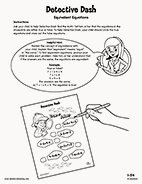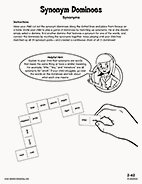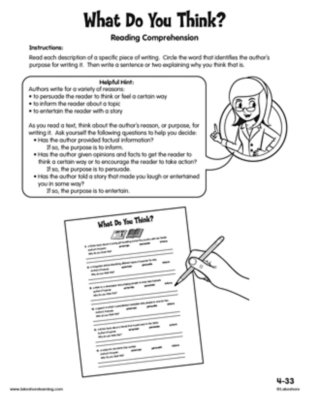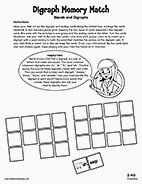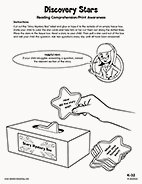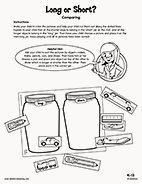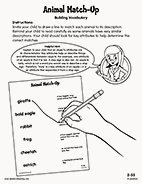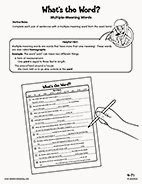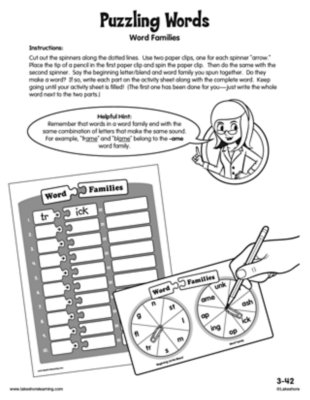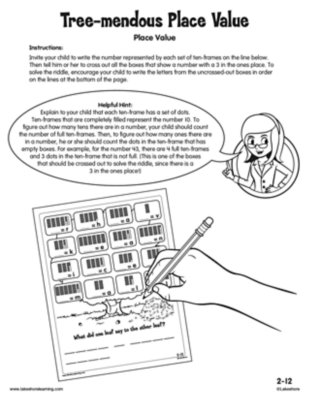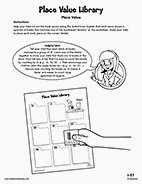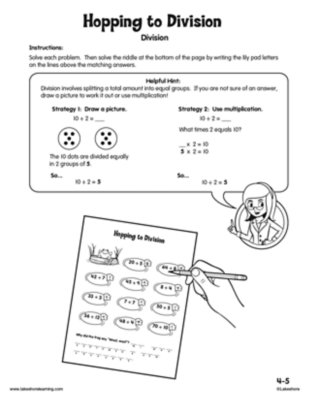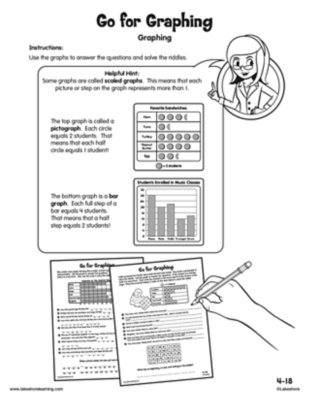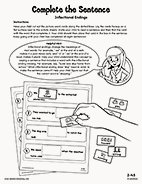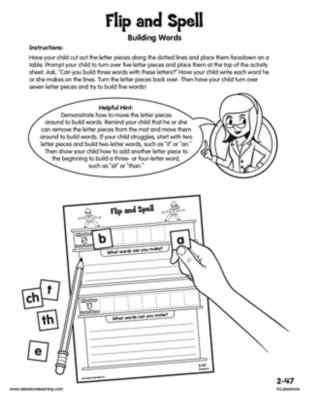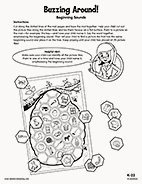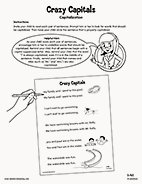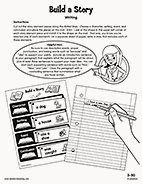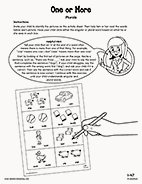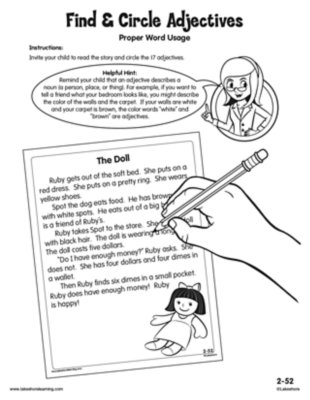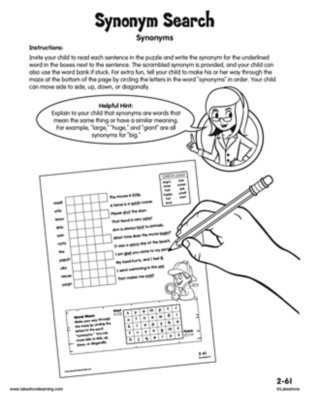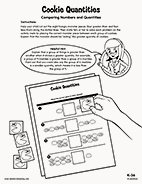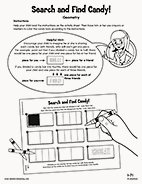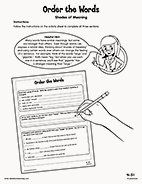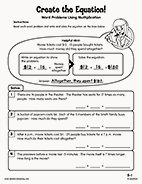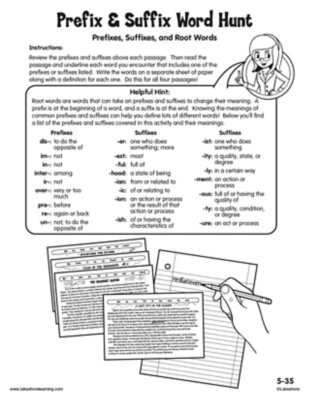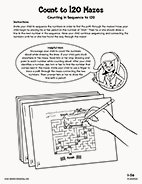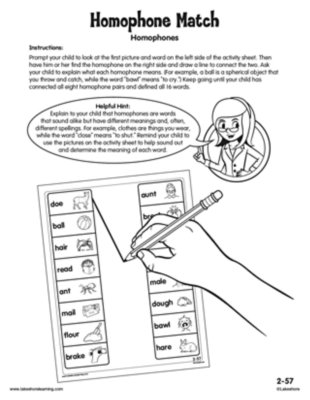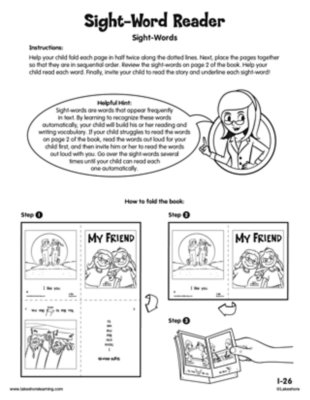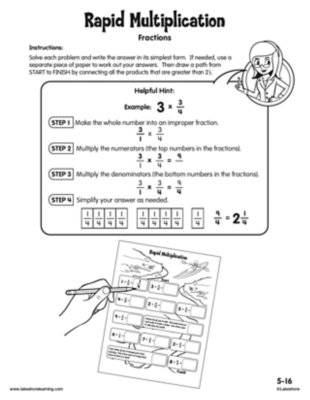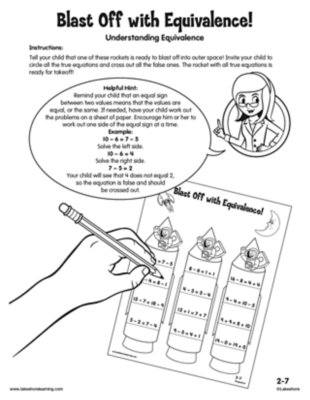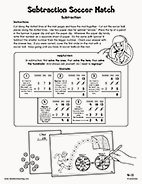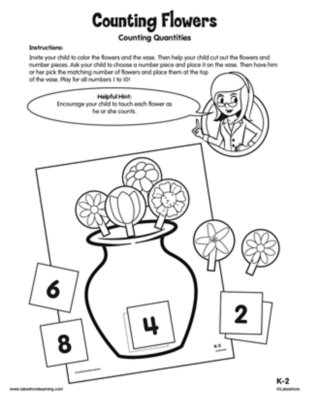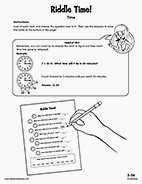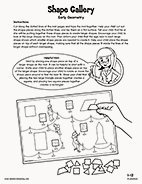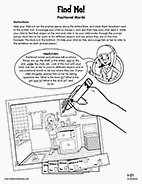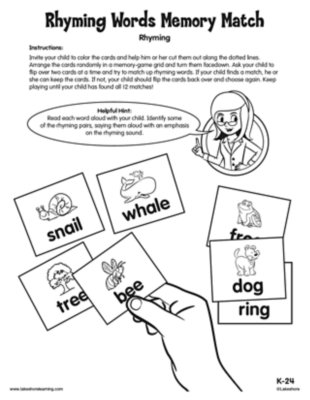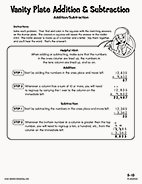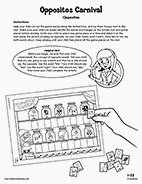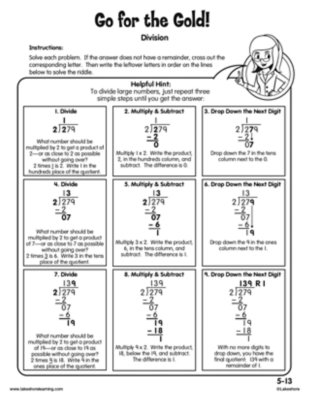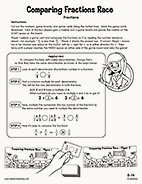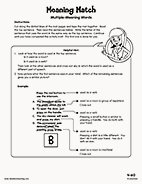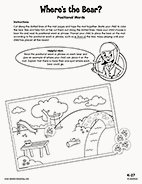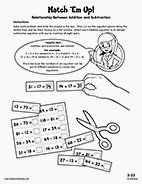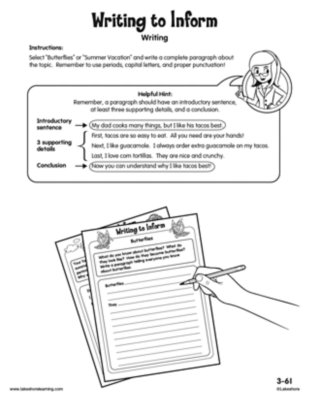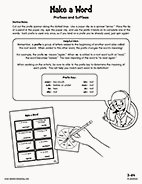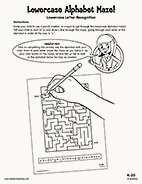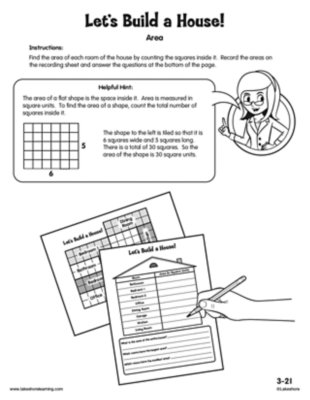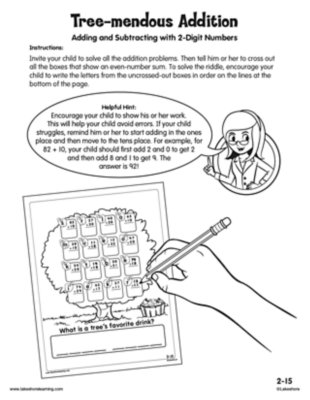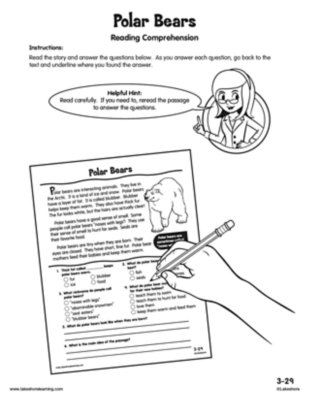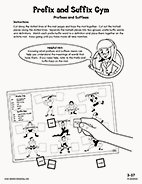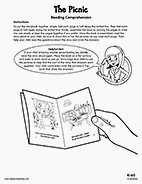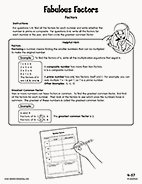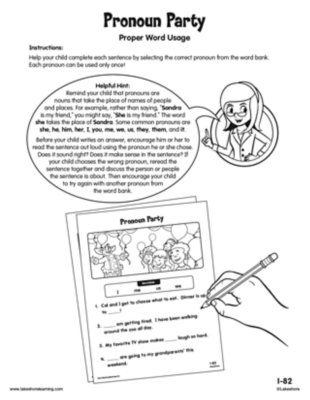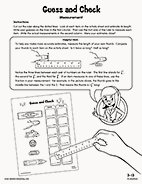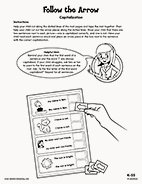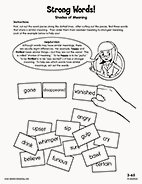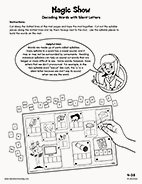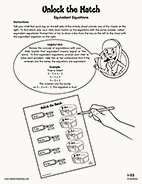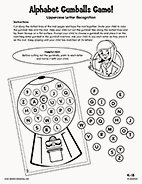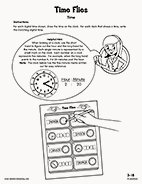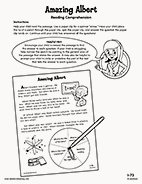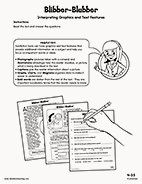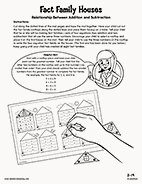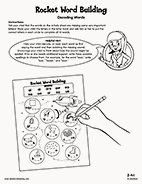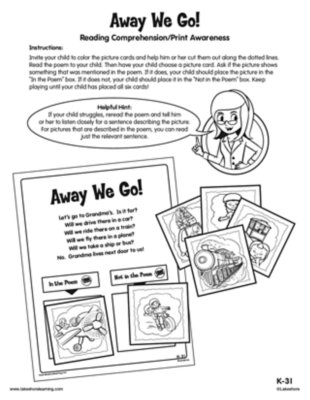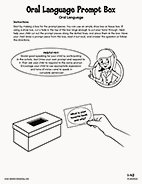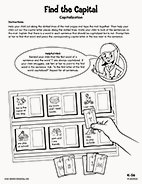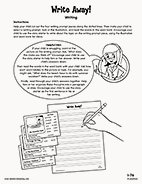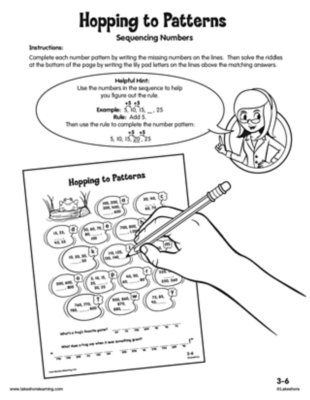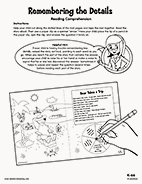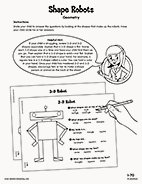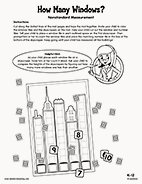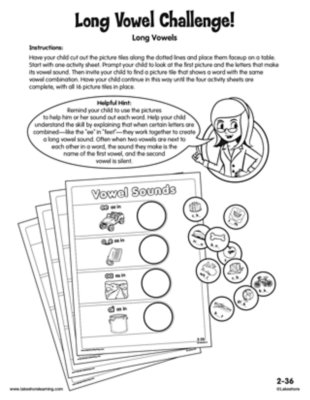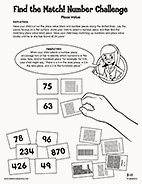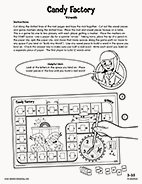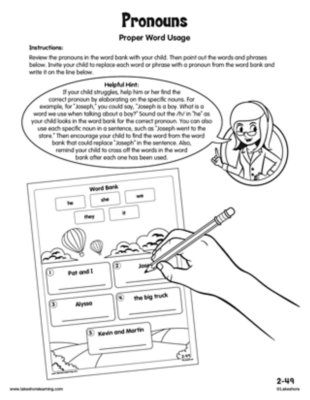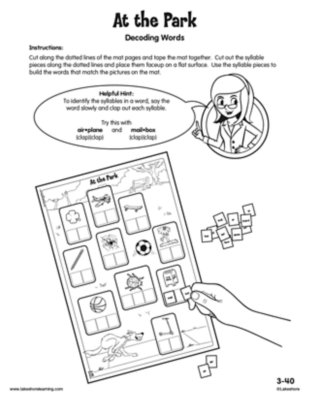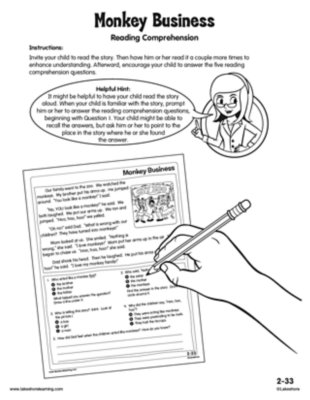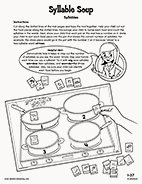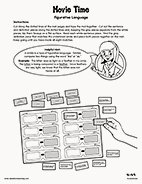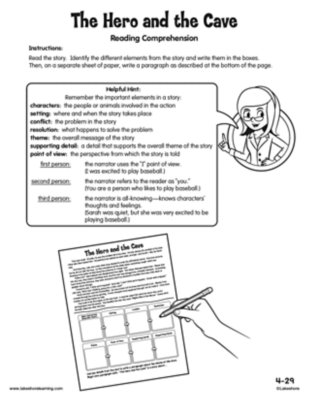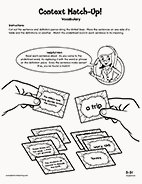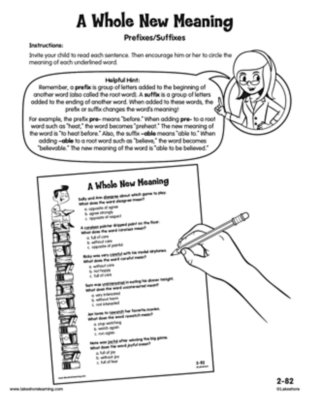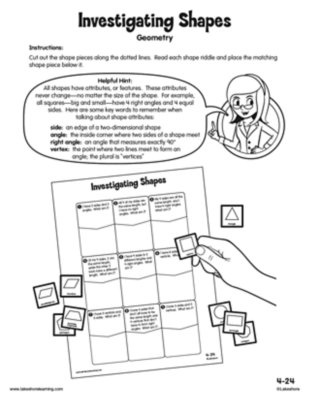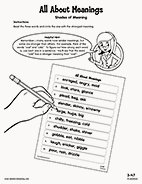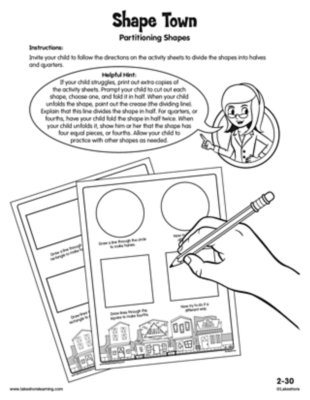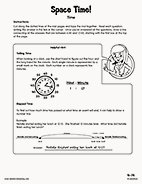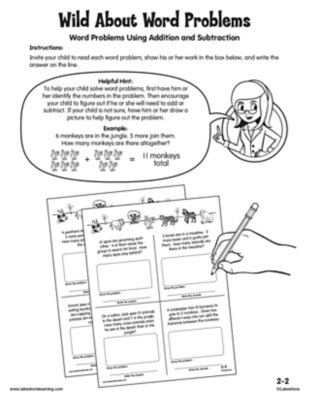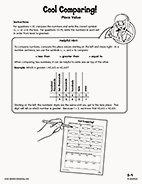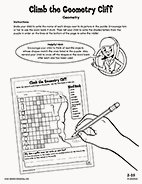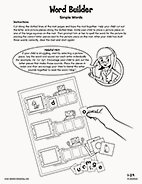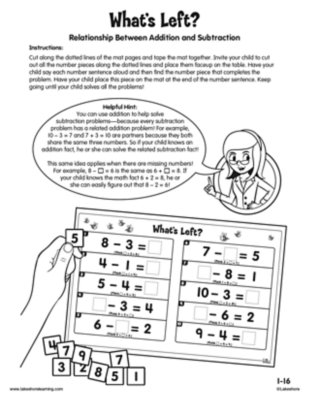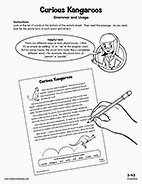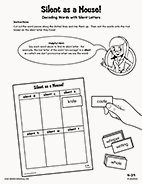
When entering fourth grade, your child should be able to decode and spell multisyllable words and grade-appropriate irregularly spelled words.
View worksheetDuring first grade, your child will learn what the equal sign means, identify whether equations are true or false and complete equations by finding missing numbers.
View worksheetWhen entering second grade, your child should be able to identify words with similar meanings and distinguish subtle differences between them. For example, “large” and “gigantic” are synonyms, but “gigantic” has a stronger meaning than “large.”
View worksheetWhen entering fourth grade, your child should be able to read and analyze level-appropriate stories, dramas, poems and informational texts, identifying elements such as main ideas, key details and the author’s purpose.
View worksheetWhen entering second grade, your child should be able to read and spell words with consonant blends, such as “st,” “sp” and “bl,” as well as common consonant digraphs, such as “th,” “ch” and “sh.”
View worksheetWhen entering kindergarten, your child should be able to listen to a story and ask and answer questions about key details, such as identifying characters and events and retelling the story in their own words. Your child should also understand the basic features of print, such as differentiating letters from words, recognizing that words have spaces between them and distinguishing the roles of authors and illustrators.
View worksheetWhen entering kindergarten, your child should be able to compare objects and describe their similarities and differences, including distinguishing by color, size, weight or shape. Your child should also be able to describe objects using the correct words, such as “big,” “small,” “short” and “tall.”
View worksheetWhen entering second grade, your child should be able to define words by category and key attributes. For example, “A duck is a bird that swims.”
View worksheetDuring fourth grade, your child will be asked to figure out the correct meanings of multiple-meaning words that appear in fourth-grade texts, such as knowing when the word “pitcher” refers to a container for pouring liquids or a person throwing a ball.
View worksheetWhen entering third grade, your child should be able to use common spelling patterns to decode and spell words easily, such as “cart,” “chart” and “smart.”
View worksheetWhen entering second grade, your child should be able to see groups of tens and ones when counting. Your child should also understand that the two digits in a two-digit number represent tens and ones. For example, there are 3 tens and 2 ones in the number 32.
View worksheetDuring first grade, your child will learn to compare two-digit numbers using greater than (>), less than (<) or equal to (=) symbols, such as 22 > 12. Your child will also learn that 10 can be thought of as a group of 10 ones—called a “ten.”
View worksheetWhen entering fourth grade, your child should be able to quickly and easily solve multiplication and division facts within 100 without having to count. For example, 9 x 9 = 81 and 56 ÷ 8 = 7.
View worksheetWhen entering fourth grade, your child should be able to use bar graphs to solve one-step and two-step problems.
View worksheetWhen entering second grade, your child should be able to read words with inflectional endings and use them correctly in sentences. Inflectional endings are letters that are added to words, such as “-ing,” “-es,” or “-ed.” For example, your child should be able to read the words “wishing,” “wishes” and “wished” and use them correctly in sentences.
View worksheetWhen entering second grade, your child should be able to build and spell simple words by blending sounds together. For example, when given the letters “a,” “e,” “c,” “b,” “d,” “g” and “s,” your child should be able to use the letters to build and read at least three words.
View worksheetWhen entering kindergarten, your child should be able to identify the initial sounds in words.
View worksheetWhen entering first grade, your child should understand that sentences begin with a capital letter and that the word “I” is also capitalized. Your child should also be able to recognize and name the punctuation marks at the end of sentences, including periods, question marks and exclamation points.
View worksheetWhen entering third grade, your child should be able to write a paragraph with an opening, three or more details and a closing.
View worksheetWhen entering first grade, your child should be able to form regular plural nouns when speaking by adding -s or -es. For example, “dog/dogs” and “wish/wishes.”
View worksheetWhen entering second grade, your child should be able to correctly use pronouns, singular and plural words, and past-, present- and future-tense words in sentences.
View worksheetWhen entering second grade, your child should be able to identify words with similar meanings and distinguish subtle differences between them. For example, “large” and “gigantic” are synonyms, but “gigantic” has a stronger meaning than “large.”
View worksheetDuring kindergarten, your child will learn to compare two numbers, determining if one is greater than, less than or equal to the other.
View worksheetDuring first grade, your child will learn the attributes of many shapes—such as the fact that a triangle has three sides—and how to divide circles and rectangles into halves and fourths. Your child will also be asked to find shapes within shapes, such as turning a square into two triangles by drawing a line from one corner to the opposite corner.
View worksheetWhen entering fourth grade, your child should be able to distinguish between shades of meaning among related words, such as “wondered,” “suspected,” “believed” and “knew.”
View worksheetWhen entering fifth grade, your child should be able to multiply and divide to solve word problems and be able to solve multistep word problems that involve multiplication and division.
View worksheetWhen entering fifth grade, your child should be able to use common, grade-appropriate Greek and Latin prefixes, suffixes and roots to figure out the meaning of a word. For example, “telegraph,” “photograph” and “autograph” all contain the Greek root “graph,” which refers to something that is written or drawn.
View worksheetDuring first grade, your child will be asked to count to 120, beginning with any number. For example, 116, 117, 118, 119, 120.
View worksheetWhen entering second grade, your child should be able to figure out the correct meanings of grade-appropriate homophones—words that sound the same but have different meaningss. For example, “to” and “two” or “eye” and “I.”
View worksheetWhen entering first grade, your child should be able to read common, high-frequency words by sight, such as “the,” “of,” “to” and “you.”
View worksheetWhen entering fifth grade, your child should be able to compare fractions, add and subtract fractions with the same denominator and multiply a fraction by a whole number.
View worksheetWhen entering second grade, your child should understand what the equal sign means. Your child should also be able to determine whether equations are true or false. For example, 5 + 3 = 6 + 2 is true, but 8 + 2 = 12 — 4 is false.
View worksheetWhen entering fourth grade, your child should be able to easily add and subtract within 1,000.
View worksheetWhen entering kindergarten, your child should be able to count to tell the number of objects.
View worksheetDuring third grade, your child will learn to tell and write time to the nearest minute. Your child will also learn to solve problems in which time has elapsed. For example, “The movie started at 5:15 p.m. It was 1 hour and 20 minutes long. What time did the movie end?”
View worksheetWhen entering first grade, your child should be able to identify 2-D (flat) and 3-D (solid) shapes, find shapes in the real world and compare shapes based on their number of sides or corners.
View worksheetWhen entering first grade, your child should be able to correctly use positional words, such as “above” and “between.”
View worksheetWhen entering kindergarten, your child should be able to recognize and match words that rhyme.
View worksheetWhen entering fifth grade, your child should be able to easily add and subtract multidigit whole numbers.
View worksheetWhen entering first grade, your child should be able to identify opposites for common adjectives and verbs, such as “happy/sad” and “stop/go.”
View worksheetWhen entering fifth grade, your child should be able to multiply a number with up to four digits by a one-digit number and a two-digit number by another two-digit number. Your child should also be able to divide numbers with up to four digits by a one-digit number, including problems with remainders.
View worksheetWhen entering fifth grade, your child should be able to compare fractions, add and subtract fractions with the same denominator and multiply a fraction by a whole number.
View worksheetDuring fourth grade, your child will be asked to figure out the correct meanings of multiple-meaning words that appear in fourth-grade texts, such as knowing when the word “pitcher” refers to a container for pouring liquids or a person throwing a ball.
View worksheetWhen entering kindergarten, your child should be able to describe the positions of objects and shapes using positional words and phrases, such as “in front of,” “behind,” “over,” “under” and “next to.”
View worksheetWhen entering third grade, your child should be able to fluently add and subtract within 100 using their knowledge of the relationship between addition and subtraction. For example, your child can solve the problem 100 — 15 = 85 by understanding that 85 + 15 = 100.
View worksheetDuring third grade, your child will learn to write opinion pieces that are supported with reasons, informative texts that convey ideas and information clearly, and narratives (stories) that include descriptive details and a clear sequence of events.
View worksheetDuring third grade, your child will learn to figure out the meaning of a new word when a prefix or suffix is added to a familiar word, such as figuring out the meaning of “preheat” based on the knowledge that “pre-” means “before.”
View worksheetWhen entering kindergarten, your child should be able to recognize and name some lowercase letters, especially those in your child’s name.
View worksheetWhen entering third grade, your child should be able to divide a rectangle into rows and columns of same-size squares and count to find the total number of them.
View worksheetWhen entering second grade, your child should be able to add and subtract using a two-digit number and a one-digit number, as well as a two-digit number and another two-digit number. For example, 22 + 20 = 42 and 41 — 10 = 31.
View worksheetWhen entering third grade, your child should be able to analyze fiction and nonfiction texts—identifying elements such as main ideas, key details and the author’s purpose.
View worksheetWhen entering third grade, your child should be able to figure out the meaning of a new word when a prefix or suffix is added to a familiar word, such as figuring out the meaning of “unhappy” based on knowledge of the word “happy.”
View worksheetDuring kindergarten, your child will be asked to listen to a story and answer questions about key details, including identifying characters and events and retelling the story in sequence.
View worksheetDuring fourth grade, your child will learn about factors, which are numbers that can be multiplied together to reach another number. For example, the factors of 6 are 1 and 6 (1 x 6 = 6), as well as 2 and 3 (2 x 3 = 6). Your child will also learn about multiples, which are numbers that are reached by multiplying one number by another. 12 is a multiple of 3 because you can multiply 3 x 4 to reach 12.
View worksheetDuring first grade, your child will learn subtleties in words’ meanings and make real-life connections between words and their use, such as understanding that both a bed and sofa could be called cozy.
View worksheetWhen entering third grade, your child should be able to measure, estimate and compare the lengths of objects in standard units, such as inches, feet, centimeters and meters.
View worksheetDuring kindergarten, your child will learn that sentences begin with a capital letter and that the word “I” is also capitalized.
View worksheetDuring third grade, your child will be expected to distinguish between shades of meaning among related words—such as “wondered,” “suspected,” “believed” and “knew”—and sort the words in order from the weakest to the strongest meaning.
View worksheetWhen entering fourth grade, your child should be able to decode and spell multisyllable words and grade-appropriate irregularly spelled words.
View worksheetDuring first grade, your child will learn what the equal sign means, identify whether equations are true or false and complete equations by finding missing numbers.
View worksheetWhen entering kindergarten, your child should be able to recognize and name some uppercase letters, especially those in your child’s name.
View worksheetWhen entering third grade, your child should be able to tell and write time from clock faces and digital clocks to the nearest five minutes. For example, 8:05 a.m. or 2:15 p.m.
View worksheetDuring first grade, your child will answer questions about key details in stories, such as identifying characters, settings and events, identifying who is telling the story and retelling the story in their own words. Your child will also learn to tell the difference between books that tell stories and books that provide information.
View worksheetWhen entering fourth grade, your child should be able to recognize common features of nonfiction text, such as diagrams, graphs and photo captions. Your child should also be able to use those features to locate information.
View worksheetWhen entering second grade, your child should understand that addition and subtraction are related. Your child should also be able to determine the missing number in an addition or subtraction equation. For example, 6 + __ = 8.
View worksheetWhen entering second grade, your child should be able to decode—or read and understand—regularly spelled one- and two-syllable words, such as “wet” or “seven.”
View worksheetWhen entering kindergarten, your child should be able to listen to a story and ask and answer questions about key details, such as identifying characters and events and retelling the story in their own words. Your child should also understand the basic features of print, such as differentiating letters from words, recognizing that words have spaces between them and distinguishing the roles of authors and illustrators.
View worksheetWhen entering first grade, your child should be able to describe familiar people, places, things and events and express their thoughts, feelings and ideas clearly.
View worksheetDuring kindergarten, your child will learn that sentences begin with a capital letter and that the word “I” is also capitalized.
View worksheetDuring first grade, your child will be asked to write opinion pieces, informative texts and narratives (stories).
View worksheetWhen entering third grade, your child should be able to count and sequence numbers within 1,000 and skip-count by 5s, 10s and 100s.
View worksheetDuring kindergarten, your child will be asked to listen to a story and answer questions about key details, including identifying characters and events and retelling the story in sequence.
View worksheetWhen entering third grade, your child should be able to solve problems using information from line plots, picture graphs and bar graphs.
View worksheetDuring first grade, your child will learn the attributes of many shapes—such as the fact that a triangle has three sides—and how to divide circles and rectangles into halves and fourths. Your child will also be asked to find shapes within shapes, such as turning a square into two triangles by drawing a line from one corner to the opposite corner.
View worksheetWhen entering kindergarten, your child should be able to identify how long something is by measuring it with like objects instead of a ruler. This is called nonstandard units of measurement. For example, “The dolphin is nine fish long.”
View worksheetWhen entering second grade, your child should understand that final -e and common vowel teams can be used to make long vowel sounds. For example, your child can recognize that the “oa” and “o_e” teams in the words “coat” and “rope” contain long “o” sounds. Your child should also be able to spell words using these vowel teams.
View worksheetWhen entering second grade, your child should be able to see groups of tens and ones when counting. Your child should also understand that the two digits in a two-digit number represent tens and ones. For example, there are 3 tens and 2 ones in the number 32.
View worksheetWhen entering third grade, your child should be able to distinguish long and short vowels when reading regularly spelled one-syllable words, such as “mad” and “made,” and know how to spell words using common vowel teams, such as “ai,” “ea,” “ee,” “oa” and “oi.”
View worksheetWhen entering second grade, your child should be able to correctly use pronouns, singular and plural words, and past-, present- and future-tense words in sentences.
View worksheetWhen entering third grade, your child should be able to decode—or read and understand—two-syllable words by applying word analysis skills and by sounding out words.
View worksheetWhen entering second grade, your child should be able to recall and identify key events, facts and details in grade-appropriate fiction and nonfiction texts.
View worksheetWhen entering first grade, your child should be able to count and say the syllables in spoken words. For example, your child should understand that “kitten” has two syllables: kit•ten.
View worksheetWhen entering fourth grade, your child should understand figurative language, such as idioms, and be able to distinguish between the literal and nonliteral meanings of words. For example, “It was a piece of cake!”
View worksheetWhen entering fourth grade, your child should be able to read and analyze level-appropriate stories, dramas, poems and informational texts, identifying elements such as main ideas, key details and the author’s purpose.
View worksheetWhen entering third grade, your child should be able to figure out the meanings of unknown words using a variety of strategies, such as looking at the context in which the word is used or consulting a dictionary.
View worksheetDuring second grade, your child will learn to figure out the meaning of a word when a prefix or suffix is added to a familiar root word, such as figuring out the meaning of “unhappy” based on the knowledge that “un-” means “not.”
View worksheetWhen entering fourth grade, your child should understand that different types of shapes can share the same attributes. For example, rhombuses, rectangles and squares all have four sides and are part of a larger group called quadrilaterals.
View worksheetWhen entering third grade, your child should be able to distinguish shades of meaning among closely related words—such as “toss,” “throw” and “hurl”—and identify which word has the strongest meaning.
View worksheetWhen entering second grade, your child should be able to divide circles and rectangles into halves and fourths and describe the parts of each using words like “halves,” “fourths” and “quarters.”
View worksheetWhen entering fourth grade, your child should know how to tell and write time to the nearest minute. Your child should also be able to solve problems in which time has elapsed. For example, “The movie started at 5:15 p.m. It was 1 hour and 20 minutes long. What time did the movie end?”
View worksheetWhen entering second grade, your child should be able to solve word problems that involve adding and subtracting within 20. This includes solving problems with up to three numbers. For example, 5 + 7 + 3 = 15.
View worksheetWhen entering fifth grade, your child should be able to compare and round multidigit numbers. Your child should also be able to read and write multidigit numbers in number, word and expanded form. For example, 765; seven hundred sixty-five; 700 + 60 + 5.
View worksheetWhen entering second grade, your child should understand the attributes of different shapes—such as a triangle’s three sides—and be able to draw a variety of 2-D shapes.
View worksheetWhen entering first grade, your child should be able to spell simple words by sounding them out, such as “c-a-t” and “f-o-x.”
View worksheetWhen entering first grade, your child should be able to use objects or drawings to answer “How many more make 10?” when given a number. Your child should also be able to use objects or drawings to break apart any number up to 10 in more than one way, such as breaking up the number 7 into 5 and 2, as well as 3 and 4.
View worksheetWhen entering third grade, your child will be expected to know many rules of English grammar and usage, including how to correctly use adjectives, adverbs, pronouns, past-tense verbs and plural words.
View worksheet
